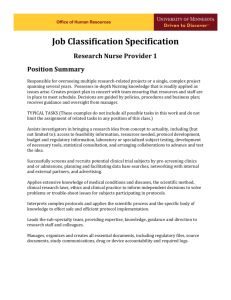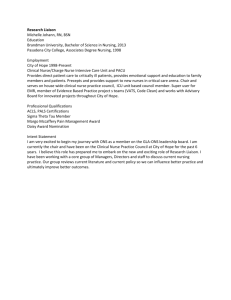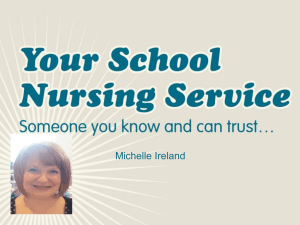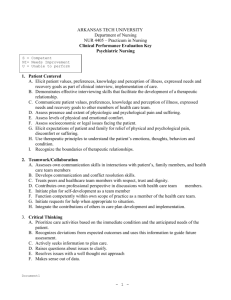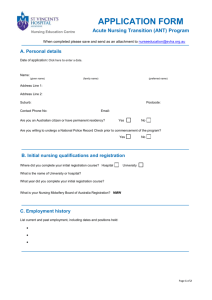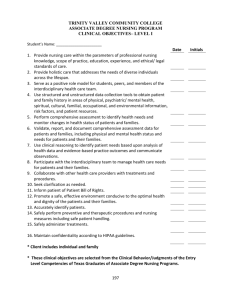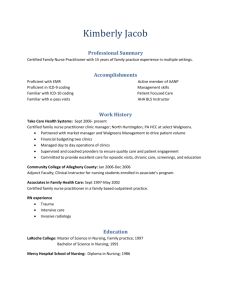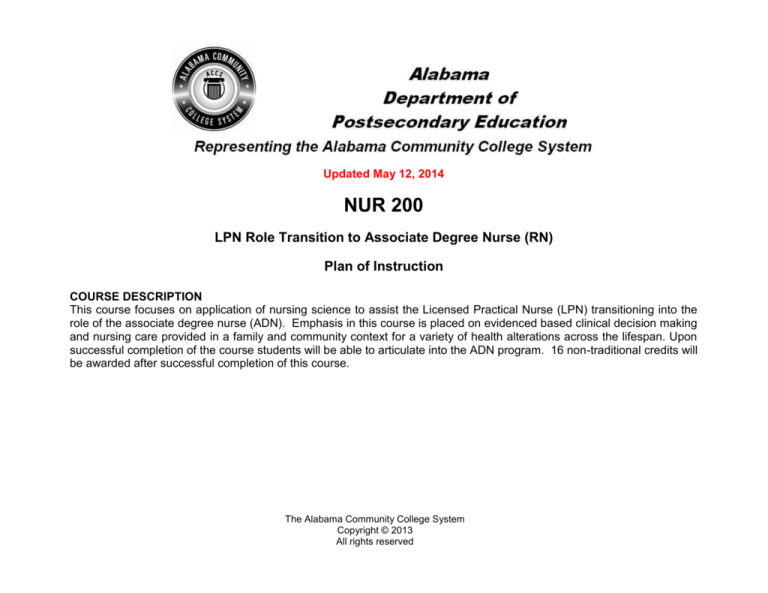
Updated May 12, 2014
NUR 200
LPN Role Transition to Associate Degree Nurse (RN)
Plan of Instruction
COURSE DESCRIPTION
This course focuses on application of nursing science to assist the Licensed Practical Nurse (LPN) transitioning into the
role of the associate degree nurse (ADN). Emphasis in this course is placed on evidenced based clinical decision making
and nursing care provided in a family and community context for a variety of health alterations across the lifespan. Upon
successful completion of the course students will be able to articulate into the ADN program. 16 non-traditional credits will
be awarded after successful completion of this course.
The Alabama Community College System
Copyright © 2013
All rights reserved
NUR 200 – LPN Role Transition to Associate Degree Nurse (RN)
CREDIT/CONTACT HOURS BREAKOUT
Theory 3 credit hours - 45 contact hours
Lab
1 credit hours - 45 contact hours
Clinical 1 credit hour – 45 contact hours
Total
5 credit hours – 9 contact hours per week
NOTE: Theory credit hours are a 1:1 contact to credit ratio. Lab and clinical hours as are 3:1 contact to credit ratio. (Ref Board
Policy 705.01)
PREREQUISITE COURSES
MTH 100 or higher level math
BIO 201, 202,
ENG 101
COURSE SPECIFIC STUDENT LEARNING OUTCOMES
Student learning outcomes specified within this course reflect current NLN and QSEN graduate competencies for the
Associate Degree Nurse.
2
ACCS Copyright© 2013
All rights reserved
NUR 200 – LPN Role Transition to Associate Degree Nurse (RN)
STUDENT LEARNING OUTCOMES
MODULE A – Role Transition
Graduate Competencies
Student Learning Outcomes
NLN
A1.0 Demonstrate knowledge, skill, and
Nursing
attitudes needed to transition from the
Judgment
LPN to the RN’s role as a member of an
Professional
inter-professional health care team with
Identity
special emphasis on scope of practice,
QSEN Safety,
personal and professional
Informatics,
responsibilities, and legal and ethical
Teamwork &
practice considerations.
Collaboration,
Patient
Centered Care
Topics:
Sample of Behavior
Nursing role and scope of practice
Scope of practice
Regulatory and accreditation agencies
Professional behaviors
Professional organizations
Therapeutic
Inter-professional team communication
communication
Informatics
Clinical decision making
HIPAA
Informatics
Technology
A1.1
A1.2
A1.3
A1.4
Objectives
Differentiate between the roles and scope of
practice of the LPN and RN as a member of an
inter-professional health care team.
Distinguish between the legal and ethical issues
related to nursing standards of practice.
State the roles of regulatory and accrediting
agencies and professional organizations related to
the discipline of nursing.
Discuss the use of relevant informatics related to
professional nursing behavior.
KSA
3
3
2
2
3
ACCS Copyright© 2013
All rights reserved
NUR 200 – LPN Role Transition to Associate Degree Nurse (RN)
MODULE B – FUNDAMENTALS OF NURSING (Ref: NUR 102)
Graduate Competencies
Student Learning Outcomes
NLN
B1.0 Apply nursing science to provide
Nursing
holistic nursing care in a family and
judgment
community context.
Spirit of inquiry
Human
flourishing
QSEN Patient centered
care
Teamwork &
collaboration
Safety
Informatics
Sample of Behavior
Professionalism
Therapeutic
communication
Clinical decision
making/nursing process
Concept map/plan of care
Mobility and restraint
Patient assessment
Pain management
Activities of daily living
Aseptic techniques
Documentation/Informatics
Objectives
Utilize clinical decision making /nursing process to
provide holistic nursing care.
B1.1.1 Discuss the concept of wellness throughout life
span.
B1.1.2 Discuss the concept of therapeutic communication
among members of the inter-professional
healthcare team, patients, and families.
B1.1.3 Outline a holistic plan of care for a patient in a
family and community context.
B1.1.4 Discuss concepts related to geriatric care.
B1.2 Utilize nursing science to provide basic care for
patients with a variety of health alterations.
Topics: (Review topics based on student assessment)
Concept of wellness
Holistic care (Concepts based care)
Activities of daily living
Rest, comfort, sleep
Nutrition/fluid balance
Oxygenation
Elimination
Psychosocial
Infection control
Therapeutic communication
Nursing process and clinical decision making
Geriatric care
Safety
Informatics
B1.1
KSA
3
3
3
2
3
3
4
ACCS Copyright© 2013
All rights reserved
NUR 200 – LPN Role Transition to Associate Degree Nurse (RN)
MODULE C – Health Assessment and Pharmacology (Ref: NUR 103/104)
Graduate Competencies
Student Learning Outcomes
NLN
C.1.0
Apply nursing science to perform an
Professional
organized head to toe assessment
identity
including a health history on patients
Nursing judgment
across the life span in a family and
Spirit of inquiry
community context.
Human
flourishing
QSEN Patient centered
care
C.2.0 Administer medication focusing on
Teamwork &
the transition from the LPN to the
collaboration
registered nurses’ scope of practice.
Safety
Informatics
Samples of Behavior
Therapeutic
communication
Nursing process/clinical
decision making
Health assessment
Administering medications
Medication disposal
Safety
Aseptic techniques
Documentation/Informatics
Objectives
Obtain a comprehensive health history.
Perform an organized physical assessment across
the lifespan.
C1.2.1 Discuss the components of a physical assessment.
C1.2.2 Distinguish between normal and abnormal findings
of a physical assessment.
C1.2.3 Discuss relevant informatics related to a physical
assessment.
C2.1 Apply nursing science to safely administer
medications to patients across the lifespan.
C2.1.1 Discuss the nurses role in patient teaching.
C2.1.2 Discuss informatics related to administering
medications.
Topics: (Review topics based on student assessment)
Health Assessments
Implications of growth and development
Health history/Physical assessment
o Subjective/Objective assessment
o Techniques for obtaining a health history/physical assessment
o Normal and abnormal assessment findings
Pharmacology
Safety
Medication administration
Informatics
C1.1
C1.2
KSA
3
3
3
3
3
3
3
2
5
ACCS Copyright© 2013
All rights reserved
NUR 200 – LPN Role Transition to Associate Degree Nurse (RN)
MODULE D – ADULT NURSING (Ref: NUR 105)
Graduate Competencies
Student Learning Outcomes
NLN
D1.0 Apply nursing science focusing on
Professional
the role of the (RN) to provide
identity
nursing care to adult patients
Nursing judgment
experiencing:
Spirit of inquiry
Perioperative care
Human flourishing
Fluid/electrolytes/acid base
QSEN Patient centered
imbalance
care
Respiratory alterations
Teamwork &
Cardiovascular alterations
collaboration
Endocrine alterations
Safety
Gastrointestinal alterations
Informatics
Musculoskeletal trauma and
alterations
D2.0 Provide safe nursing care in the
administration of IV therapy within a
family and community context.
D1.1
D1.1.1
D1.1.2
D1.1.3
D1.1.4
D1.1.5
D1.2
D2.1
D2.1.1
D2.1.2
D2.1.3
D2.1.4
D2.1.5
D2.1.6
D2.2
Objectives
Apply clinical decision making in providing nursing
care for selected adult patient concepts.
Describe clinical manifestations and diagnostic
tests for selected adult patient concepts.
Describe the inter-professional collaborative
approach for selected adult patient concepts.
Explain the pharmacological agents and/or
treatments for selected adult patient concepts.
Explain health promotion related to selected adult
patient concepts.
Discuss psychosocial needs of adult patients
within the family and community context.
Apply critical elements of relevant
documentation/informatics.
KSA
3
Perform venipuncture and IV therapy.
Summarize scope of practice and specified legal
and ethical issues related to venipuncture, IV
therapy and blood specimen collection.
Interpret doctor’s orders for venipuncture and IV
therapy.
Explain the rationale for selecting IV solutions.
Select appropriate equipment and supplies for
specified venipuncture and IV therapy.
Discuss nursing intervention for venipuncture and
IV therapy.
Discuss complications related to venipuncture
and IV therapy.
Apply documentation informatics related to
venipuncture and IV therapy.
3
2
3
3
3
3
3
3
3
3
3
3
3
3
6
ACCS Copyright© 2013
All rights reserved
NUR 200 – LPN Role Transition to Associate Degree Nurse (RN)
MODULE D – ADULT NURSING (Ref: NUR 105)
D3.0 Apply the principles of IV therapy to D3.1 Administer blood and blood products.
safely administer blood and blood
D3.1.1 Explain the principles inherent to the administration
products to culturally diverse
of blood and blood products.
patients.
Sample of Behavior:
Topics: (Review topics based on student assessment)
Assessment
Select adult concepts
Clinical decision making/nursing process
Therapeutic communication
Perioperative care
Clinical manifestations
Clinical decision making
Fluid/electrolytes/acid base imbalance
Diagnostic tests
Health promotions and
Respiratory alterations
Evidenced based practice
screening
Cardiovascular alterations
Interprofessional collaborative approach
Medication administration
Endocrine alterations
Pharmacological agents and treatments
Nursing interventions
Gastrointestinal alterations
Health promotion
Documentation/Informatics
Musculoskeletal trauma and alterations
Psychosocial needs
Documentation/Informatics
3
3
7
ACCS Copyright© 2013
All rights reserved
NUR 200 – LPN Role Transition to Associate Degree Nurse (RN)
MODULE E – MATERNAL AND CHILD NURSING (Ref: NUR 106)
Graduate Competencies
Student Learning Outcomes
NLN
E.1.0
Apply
clinical decision making for
Professional
patients during the child bearing cycle
identity
within the family and community
Nursing judgment
context.
Spirit of inquiry
Human
flourishing
QSEN Patient centered
care
Teamwork &
collaboration
Safety
Informatics
E1.1
E1.1.1
E1.1.2
E1.1.3
E1.1.4
E1.1.5
E1.2
E2.0
Apply nursing science using growth
and development concepts to provide
nursing care for pediatric patients
within a family and community context
experiencing:
Perioperative care
Fluid/electrolytes/acid base
imbalance
Respiratory alterations
Cardiovascular alterations
Endocrine alterations
Gastrointestinal alterations
Musculoskeletal trauma and
alterations
E2.1
E2.1.1
E2.1.2
E2.1.3
E2.1.4
E2.1.5
E2.2
Objectives
Apply clinical decision making in providing nursing
care for patients during the child bearing cycle.
Describe normal and abnormal clinical
manifestations and diagnostic tests for patients
during the child bearing cycle.
Describe the inter-professional collaborative
approach for patients during the child bearing
cycle.
Explain the pharmacological agents and/or
treatments for patients during the child bearing
cycle.
Explain health promotion related to patients
during the child bearing cycle
Discuss psychosocial needs for patients during
the child bearing cycle within the family and
community context.
Apply critical elements of relevant
documentation/informatics.
Apply clinical decision making in providing nursing
care for pediatric patients.
Describe clinical manifestations and diagnostic
tests for various pediatric health alterations.
Describe the inter-professional collaborative
approach for pediatric patients.
Explain the pharmacological agents and/or
treatments for pediatric patients.
Explain health promotion related to pediatric
patients
Discuss psychosocial needs for pediatric patients
within the family and community context.
Apply critical elements of relevant
documentation/informatics.
KSA
3
3
3
3
3
3
3
3
3
3
3
3
3
3
8
ACCS Copyright© 2013
All rights reserved
NUR 200 – LPN Role Transition to Associate Degree Nurse (RN)
MODULE E – MATERNAL AND CHILD NURSING (Ref: NUR 106)
Samples of Behavior:
Topics: (Review topics based on student assessment)
Assessment
Child bearing cycle
Therapeutic
Antepartum
communication
Intrapartum
Teaching plan
Postpartum
Clinical decision making
Complications of pregnancy
Health promotions and
Newborn care
screening
Pediatric care
Medication administration
Concept of wellness
Nursing interventions
Perioperative care
Documentation/Informatics
Fluid/electrolytes/acid base imbalance
Respiratory alterations
Cardiovascular alterations
Endocrine alterations
Gastrointestinal alterations
Musculoskeletal trauma and alterations
Teaching and learning concepts
Informatics
9
ACCS Copyright© 2013
All rights reserved
NUR 200 – LPN Role Transition to Associate Degree Nurse (RN)
MODULE F – Nursing Skills
Graduate Competencies
NLN
Professional
identity
Nursing judgment
Spirit of inquiry
Human
flourishing
QSEN Patient centered
care
Teamwork &
collaboration
Safety
Informatics
Samples of Behavior:
Assessment
Therapeutic
communication
Teaching plan
Clinical decision making
Health promotions and
screening
Medication administration
Nursing interventions
Sterile Technique
Medical Asepsis
Safety
Documentation/Informatics
Student Learning Outcomes
F.1.0 Apply clinical decision making to safely
F1.1
perform nursing skills for patients across
the life span including but not limited to:
F1.1.1
Health History
Head to toe Physical Assessment
F1.1.2
Vital Signs
Medication administration through
F1.1.3
various routes
Procedure requiring sterile
Technique such as catherizations
Nasogastric Intubations /tube feeding F1.1.4
Respiratory
F1.2
procedures/tracheostomy care
Elimination procedures
Safety procedures including National
Patient Safety Goals
Pain assessment
Topics: (Review topics based on student assessment)
Basic Nursing Skills
Vital Signs
Safety precautions
Medication administration
Health assessment
Health history
Sterile procedures
IV Therapy and venipuncture
Pain Management
Objectives
Apply clinical decision making in performing
basic nursing skills for patients across the life
span.
Discuss safety guidelines for implementation of
nursing skills.
Describe the inter-professional collaborative
approach for patients requiring nursing skills.
Explain the national safety goals as a tool for
health promotion related to patients requiring
nursing skills
Discuss psychosocial needs for patients
requiring the various nursing skills.
Apply critical elements of relevant
documentation/informatics.
KSA
3
3
3
3
3
3
10
ACCS Copyright© 2013
All rights reserved
NUR 200 – LPN Role Transition to Associate Degree Nurse (RN)
STUDENT LEARNING OUTCOMES TEST BLUEPRINT
The table below identifies the percentage of cognitive objectives for each module. Instructors should develop sufficient numbers of test
items at the appropriate level of evaluation.
Limited Knowledge
and Proficiency
Module A
Module B
Module C
Module D
Module E
Module F
Indicator
Key Terms
1
Limited
Knowledge and
Proficiency
2
Moderate
Knowledge and
Proficiency
3
Advanced
Knowledge and
Proficiency
4
Superior
Knowledge and
Proficiency
A
Affective
Objective
1
-
Moderate
Knowledge and
Proficiency
2
66%
40%
-
Advanced
Knowledge and
Proficiency
3
34%
60%
100%
100%
100%
100%
Superior
Knowledge and
Proficiency
4
-
Description
Recognize basic information about the subject including terms and nomenclature.
Demonstrate ability to recall information such as facts, terminology or rules related to information previously taught.
Performs simple parts of the competency. Student requires close supervision when performing the competency.
Distinguish relationships between general principles and facts. Adopts prescribed methodologies and concepts.
Demonstrate understanding of multiple facts and principles and their relationships, and differentiate between
elements of information. Students state ideal sequence for performing task.
Performs most parts of the competency with instructor assistance as appropriate.
Examines conditions, findings, or other relevant data to select an appropriate response.
The ability to determine why and when a particular response is appropriate and predict anticipated outcomes.
Students demonstrate their ability to seek additional information and incorporate new findings into the conclusion
and justify their answers.
Performs all parts of the competency without instructor assistance.
Assessing conditions, findings, data, and relevant theory to formulate appropriate responses and develop
procedures for situation resolution. Involves higher levels of cognitive reasoning.
Requires students to formulate connections between relevant ideas and observations.
Students apply judgments to the value of alternatives and select the most appropriate response.
Can instruct others how to do the competency.
Performs competency quickly and accurately.
Describes learning objectives that emphasize a feeling tone, an emotion, or a degree of acceptance or rejection.
Objectives vary from simple attention to selected phenomena to complex but internally consistent qualities of
character and conscience.
Expressed as interests, attitudes, appreciations, values, and emotional sets or biases.
11
ACCS Copyright© 2013
All rights reserved
NUR 200 – LPN Role Transition to Associate Degree Nurse (RN)
Clinical decision making
Community
Co-requisite course
Human Flourishing
Informatics
Instructional goals
Knowledge, Skills, and
Abilities (KSA) Indicators
Graduate Competencies
Lifespan
NLN
Child bearing cycle
Nursing
Science
QSEN/QSEN Institute
Plan of Instruction (POI)
Prerequisite courses
Samples of Behavior
Student learning
Glossary of Terms
A type of decision-making that combines clinical expertise, patient concerns, and evidence gathered from nursing
science to arrive at a diagnosis and treatment recommendations within the scope of practice.
A group of people with diverse characteristics who are linked by social ties, location, culture or the sharing of joint
actions . (National Institute of Health)
Courses that are taken in conjunction to a specified course. These are often in the form of associated laboratory or
clinical courses.
Human flourishing is difficult to define, but it can be loosely expressed as an effort to achieve self-actualization and
fulfillment within the context of a larger community of individuals, each with the right to pursue his or her own such
efforts. The process of achieving human flourishing is a lifelong existential journey of hope, regret, loss, illness,
suffering, and achievement. Human flourishing encompasses the uniqueness, dignity, diversity, freedom, happiness,
and holistic well-being of the individual within the larger family, community, and population. The nurse helps the
individual in efforts to reclaim or develop new pathways toward human flourishing.
The "science and practice (that) integrates nursing, its information and knowledge, with management of information
and communication technologies to promote the health of families and communities." (adapted from IMIA Special
Interest Group on Nursing Informatics 2009)
Broad desired outcomes for a specified course that relate to cognitive, psychomotor, and affective objectives.
An alpha-numeric designator indicating the scope and depth of student learning and level of teaching and
measurement by faculty. KSAs represent terminal levels and should be represented by adequate coverage within all
measurement instruments related to the specified student learning outcome.
Knowledge expected of someone at the end of a nursing program that will be taken into practice.
The duration of existence of an individual
National League for Nursing
The antepartal, intrapartal, and postpartal periods of pregnancy from conception to 6 weeks after birth.
A domain of knowledge concerned with the adaptation of individuals and groups to actual or potential health problems,
the environments that influence health in humans, and the therapeutic interventions that promote health and affect the
consequences of illness. (Kim, 1994, p. 145)
Quality and Safety Education for Nurses
Serves as a course control document to specify minimum content, objectives, and scope of instruction and
measurement for a given course. Faculty may exceed the content but must include the content provided in the POI.
This document is used to establish standardized instruction throughout the college system for a specified discipline.
Faculty uses this document to make decisions related to delivery of the course to include content, methodology,
instructional materials, and student measurement. This document also serves as the basis for syllabi and lesson plan
development.
Courses that must be successfully completed prior to admission into a specified course.
Required behaviors observed during performance measures.
Statements of expectations written in measurable terms that express what a student will know, do, or think at the end
12
ACCS Copyright© 2013
All rights reserved
NUR 200 – LPN Role Transition to Associate Degree Nurse (RN)
outcomes
Student learning
outcomes test blueprint
Nursing Judgment
Professional Identity
Spirit of Inquiry
of a learning experience; characteristics of the student at the completion of a course and/or program. Learning
outcomes are measurable, learner-oriented abilities that are consistent with standards of professional practice.
Used to ensure adequate sampling of student knowledge as specified by the cognitive student learning outcomes
within a specific module.
Nursing Judgment encompasses three processes: namely, critical thinking, clinical judgment, and integration of best
evidence into practice. Nurses must employ these processes as they make decisions about clinical care, the
development and application of research and the broader dissemination of insights and research findings to the
community, and management and resource allocation.
Critical thinking means identifying, evaluating, and using evidence to guide decision making by means of logic and
reasoning. Clinical judgment refers to a process of observing, interpreting, responding, and reflecting situated within
and emerging from the nurse’s knowledge and perspective (Tanner, 2006). Integration of best evidence ensures that
clinical decisions are informed to the extent possible by current research (Craig & Smith, 2007).
Professional identity involves the internalization of core values and perspectives recognized as integral to the art and
science of nursing. These core values become self-evident as the nurse learns, gains experience, and grows in the
profession. The nurse embraces these fundamental values in every aspect of practice while working to improve patient
outcomes and promote the ideals of the nursing profession. Professional identity is evident in the lived experience of
the nurse, in his or her ways of “being,” “knowing,” and “doing.”
A spirit of inquiry is a persistent sense of curiosity that informs both learning and practice. A nurse infused by a spirit of
inquiry will raise questions, challenge traditional and existing practices, and seek creative approaches to problems.
The spirit of inquiry suggests, to some degree, a childlike sense of wonder. A spirit of inquiry in nursing engenders
innovative thinking and extends possibilities for discovering novel solutions in ambiguous, uncertain, and unpredictable
situations.
13
ACCS Copyright© 2013
All rights reserved

